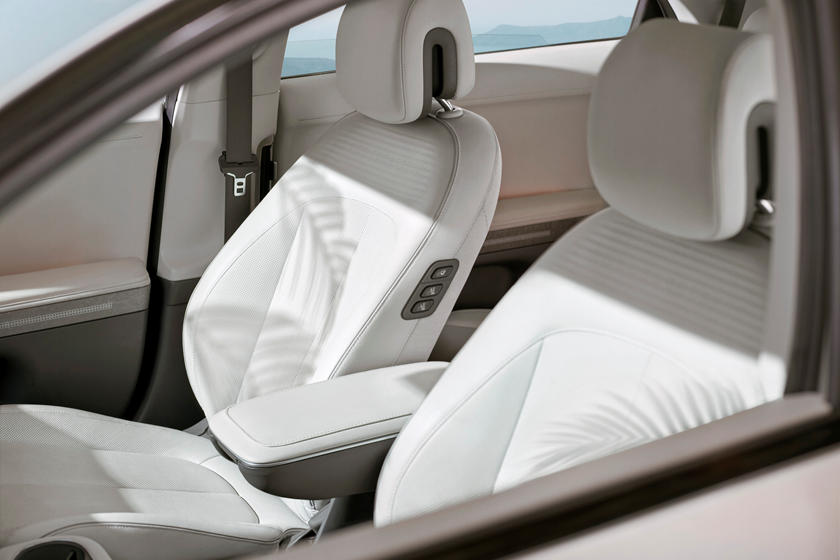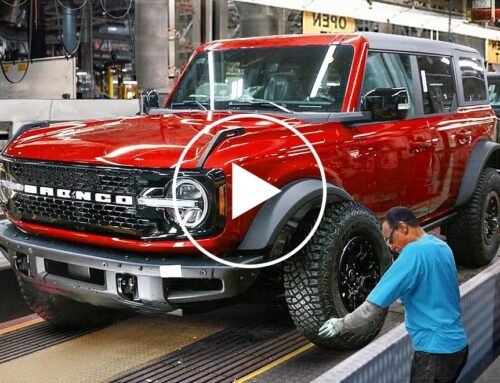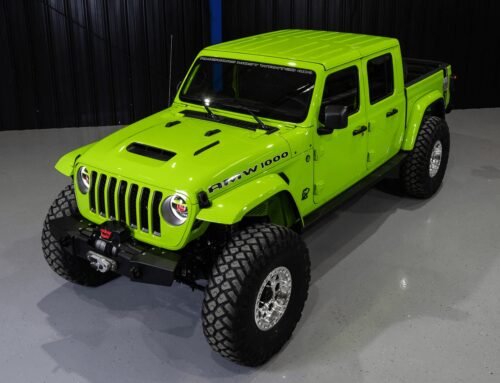Hyundai’s new electric crossover looks special.
Hyundai is kicking off its new electric sub-brand with an absolute beauty. The Ioniq 5 is a mid-size crossover with hot hatch proportions. Or perhaps it’s just a very big hatchback – the jury is still out. Whatever you want to call it, it’s oozing style. While the design is sharp and modern, including the Z-shaped crease that’s part of Hyundai’s new design language, Hyundai says the Ioniq 5 was inspired by its first production car. We’ve squinted at it from all angles and don’t see it though. What we do see is a good-looking car with an innovative interior and a promising drivetrain. So let’s dig into its coolest features.
 Hyundai
Hyundai
1. Thoughtful Aesthetic Design
Hyundai has come a long, long, long way when it comes to aesthetics, but there’s more to the Ionic 5 than next-generation European hot hatch looks. The Parametric Pixel lights, with their pixel-like clusters, are an artful acknowledgment of the Ioniq 5’s digital origins. Simultaneously, the clamshell hood and flush door handles are old-school tricks to maximize aerodynamic efficiency. The aero-optimized wheels will be available in sizes up to 20 inches and carry on the Parametric Pixel design theme. There’s a lot to love about the Ioniq 5’s styling, but the light clusters are arguably the coolest individual aspect.
 Hyundai
Hyundai
 Hyundai
Hyundai
 Hyundai
Hyundai
 Hyundai
Hyundai
2. Room For Activities
The Ioniq 5 has a 118-inch wheelbase, which is nearly four inches longer than Hyundai’s three-row Palisade SUV. However, the interior is unencumbered by a transmission tunnel and features a flat floor. That gives Hyundai room to apply what it calls a ‘Living Space’ theme to the interior. That means plenty of room to stretch out and relax, as well as lots of headroom and large amounts of useable storage space, including storage for a purse. The seats recline, complete with a (likely optional) first-class-cabin-style lower leg support on the front seats. Hyundai is even touting a single-pane glass ceiling so you can lay back and look at the stars. Lastly, and importantly, you can store all your stuff in 18.7 cubic feet of trunk space.
 Hyundai
Hyundai
 Hyundai
Hyundai
 Hyundai
Hyundai
 Hyundai
Hyundai
3. Solid Performance Meets Balanced Range
Power comes from either a 58-kWh or 72.6-kWh battery pack hooked up to a single rear electric motor or a dual-motor layout. With the two-wheel-drive configuration and a 72.6-kWh battery, the Ioniq 5 will jog up to 62 mph in 7.4 seconds while getting a range of almost 300 miles. The all-wheel-drive variant with the 72.6-kWh battery generates a healthy 301 horsepower and 446 lb-ft of torque and will sprint from 0-62 mph in 5.2 seconds and top out at 100 mph. These aren’t earth-shattering figures, but they’re more than adequate for the trendy family on the move.
From a range perspective, the WLTP test cycles suggest between 292 and 298 miles is capable on 2WD models with the larger battery. This will likely drop to around 220 miles when the EPA gets its mitts on the Ioniq 5.
4. Convenient Charging Technology
For electric vehicles to become widely adopted, charging the batteries needs to be quick and convenient. Hyundai claims that the Ioniq 5 can be charged from ten percent to 90 percent in 18 minutes using a 350-kW charger, which is a great start. The South Korean automaker also says that up to 62 miles of range can be recharged in just five minutes. For convenience, owners can start and stop charging with the touch of a button on their smartphone app, and Remote Climate Control gives the option of scheduling the vehicle’s pre-heating while connected to a power source. Hyundai’s E-GMP charging system can support both 400-V and 800-V charging infrastructures by using the motor and an inverter to boost 400 V to 800 V for stable charging.
5. Augmented Reality HUD
In its press release, Hyundai glosses over its Augmented Reality Head-Up Display (AR HUD). It shouldn’t, because the ability to turn the windshield into a display screen is crazy cool, especially when AR is involved. Plans for creating one for the brand started in 2020 when Hyundai Mobis, Hyundai’s parts and service arm, invested in Envisics, a UK-based AR HUD company. Hyundai hasn’t given any real details about the system yet, but we assume it’s similar to Mercedes-Benz’s AR-HUD technology. That said, with so much hype around it, we certainly expect some unique features to be debuted when the car arrives.
6. Next-Level Hyundai SmartSense
Hyundai’s semi-autonomous “Highway Driving Assist 2” (HDA2) has also been in development since 2017. Again, Hyundai glosses over it, but it’s developed to be a Level 2 autonomous feature, similar to Tesla’s Autopilot. On the GV80, the system maintains a safe distance, and “when the turn signal is used at over 60km/h, it helps to merge in congested situations.” It also includes Smart Cruise Control, which learns drivers’ habits regarding things like speed and distances between the car in front held on the freeway. These features take the stress out of daily commuting and enhance safety – always ideal in a family runabout.
7. It’s A Charger On Four Wheels
The Ioniq 5 has a V2L (Vehicle-To-Load system), which is essentially an output system that uses an inverter so the vehicle can be used as a charger. You can charge phones through USB ports, but this is for larger equipment like electric bicycles. There are two V2L ports on the car, one under the second-row passenger seats, and the other is outside and tucked away next to the charging socket. The Ford F-150 has something similar, and its benefits have proven to be extraordinary in beleaguered Texas.
8. Eco-Friendly Interior Materials
Moving to electric power for cars while at the same time shifting the generation of electricity to renewable sources is where the auto industry and society are headed. The other shift in the auto industry is towards using sustainably sourced materials and more eco-friendly materials. They’re quite a way from avoiding using new plastics entirely, but automakers are starting to minimize their use. Inside the Ioniq 5, many touchpoints like the seats, armrests, door trim, and floor covering are made using more ecologically friendly materials. Those materials include recycled PET bottle plastics, plant-based yarns, natural wool yarns, leather processed with plant-based extracts rather than harmful chemicals as key tanning ingredients, and even paint using plant extracts for pigment.
All in all, it’s a compelling package, and we can’t wait to see if the all-new crossover is as good as it looks.
 Hyundai
Hyundai
 Hyundai
Hyundai
 Hyundai
Hyundai
 Hyundai
Hyundai
 Hyundai
Hyundai
 Hyundai
Hyundai





